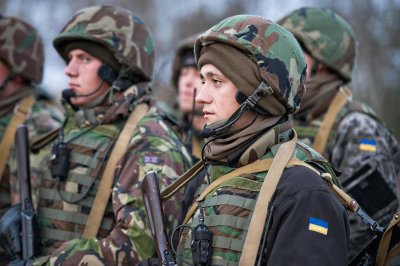As it looks now, there are two potential spring offensives in Ukraine. Either of these offensives would be laden with significant risks for both sides. Predicting the outcome is difficult because outside players may intervene, especially US and NATO forces.
The first offensive is fairly well known. It is the spring offensive being organized by the Russian army. Considerable preparations have been made over many months. The Russians have honed their tactics, brought in new offensive weapons and replaced equipment so far lost in the war, especially tanks and infantry fighting vehicles.
One report suggests that Russian production of tanks, including T-90s and T-14 Armtas, is running at a high level. Manufacturing of other weapons, especially ammunition of all types, also appears to have been accelerated.
What isn’t known is how the Russians will use the large force they have assembled, numbering between 200,000 to 300,000. One theory is they will move out from the south and east in a wide encirclement trying to trap Ukrainian forces.
Another is that they will use the encirclement to tie down the Ukrainians while making a dash for Kyiv from three sides (south, east and north). This may be their best bet, but it is questionable whether they have the manpower to do the job, or enough mobility to escape Ukrainian counterattacks.
The other spring offensive is the one that Ukraine is preparing for in earnest. This offensive probably has been planned in the Pentagon rather than in Kyiv.
Huge amounts of equipment either have arrived already in Poland, where they’re ready to be moved into Ukrainian territory, or are on their way. In addition, NATO is rapidly bolstering its forces. This past Saturday the US-flagged vehicle carrier Liberty Pride sailed into the port of Alexandroupolis, Greece, carrying military equipment destined for NATO forces.

How many other US ships are in the ocean at the moment or arriving at other ports, isn’t yet known. But what is known is that NATO is girding itself for a spillover, once the Ukrainian offensive gets underway.
The main focus of the Ukrainian spring offensive likely is an assault on Crimea and on Russian forces in the south. The objective is to cut them off (Kherson area across to Zaphorizia) and systematically destroy them, followed by a big push into Crimea.
The US is supplying a huge amount of war materiel for this assault. It includes bridging equipment that can support German-origin Leopard II tanks, which weigh more than 62 tons (roughly the same as the phantom M1 Abrams tanks that won’t arrive until next year, if ever).
Ukraine will have its hands full in such an operation and is dependent on US intelligence and, very likely, US airpower. There is not enough time to train Ukrainian pilots on F-16s, and there are not any spare up-to-date F-16s to throw into the battle – unless, of course, US fighter squadrons are in the mix.
One can expect that US aircraft will be painted over with Ukrainian insignia and flown by US or NATO pilots. These planes will operate as standoff assets, firing long-range air-to-air and air-to-ground weapons.
By staying wide of Russian air defense systems, but protected by what remains of Ukrainian air defenses, the F-16s could target Russian armor, command centers, troop formations, caravans, jammers and air defense radars.
The Ukrainian offensive also is likely to appear to the Russians as a casus belli involving NATO direct participation. How Russia might respond to a direct challenge is hard to say. The most likely Russian response could be to attack stockpiles and massing areas in Poland and Romania – and, almost certainly, airfields supporting the war.
Russian strategists have the opinion that Polish forces might also move into Ukraine, perhaps taking Lviv (Lvov) or other prizes, hedging that the Ukrainian offensive might fail or that the Russians are successful in toppling Kyiv’s government.
If these prognostications on the two spring offensives are anywhere near correct – and there is plenty of evidence suggesting both offensives are being prepared – then Europe is on the brink of a great catastrophe.
Stephen Bryen is a senior fellow at the Center for Security Policy and the Yorktown Institute. Follow him on Twitter at @stevebryen

